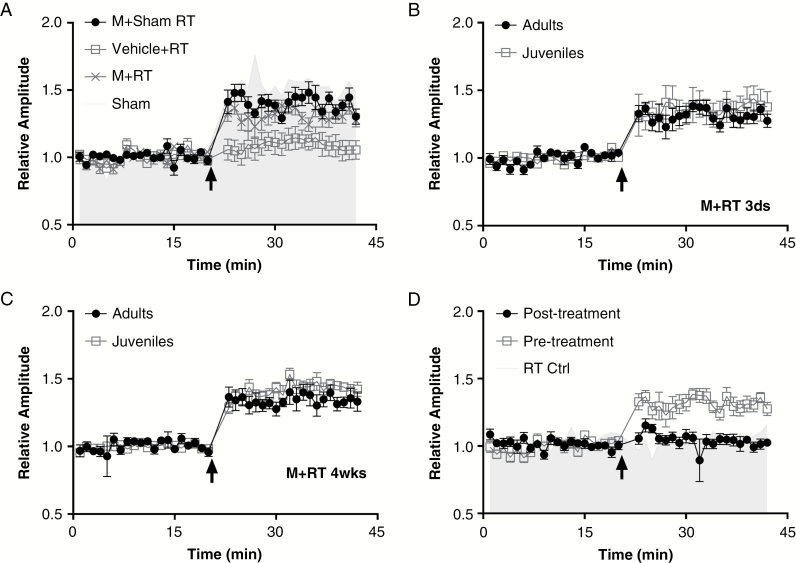Fig. 3.
Giving memantine before irradiation, but not afterward, preserved long-term potentiation at the hippocampal–PFC pathway. (A) Pretreatment with memantine (M) had significant protective effects on long-term potentiation (LTP) at 3 days after cranial irradiation [RT]/sham exposure [F(3,76) = 242.4, P < 0.001]. Memantine (at 0.5 mg/kg) or vehicle was given by oral gavage to adult rats at 25 hours and 1 hour before irradiation. This pretreatment protected the LTP (131.3% ± 1.0% [n = 6]) from RT-induced depression (Vehicle + RT, 109.1% ± 0.8% [n = 6] P < 0.001), although that protection was not complete (compare with Sham, 153.1% ± 1.6% [n = 6], P < 0.001). Memantine treatment alone did not affect LTP at the hippocampal–PFC pathway (Memantine + sham, 151.3% ± 1.6% [n = 6] vs Sham, P = 0.755). (B, C), LTP measured 3 days after memantine + RT (B) or 4 weeks after memantine + RT (C) in juvenile and adult rats. No difference was detected in LTP preservation between juveniles and adults either at day 3 (131.3% ± 1.0% [n = 6] vs 135.9% ± 0.9% [n = 6], P = 0.526) or at week 4 (141.4% ± 1.2% [n = 6] vs 141.2% ± 1.8% [n = 6], P = 1.000), or groups × time [F(3.76) = 2.087, P = 0.109]. (D). Memantine was given (0.5 mg/kg by oral gavage) to adult rats at 1 hour and 25 hours before or after cranial irradiation (RT), with distinct outcomes according to protocol [F(2, 57) = 184.1, P < 0.001]. Specifically, giving memantine after irradiation did not prevent RT-induced inhibition of LTP (104.2% ± 1.1% [n = 6], P = 0.873 vs RT control, which was significantly lower than LTP when memantine was given before irradiation [138.8% ± 1.8% [n = 6], P < 0.001]).

